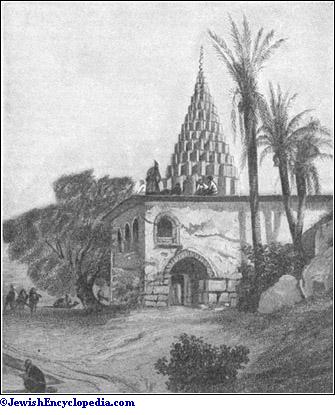Daniel, Tomb Of
 From Jewish Encyclopedia (1906)
From Jewish Encyclopedia (1906) Daniel, Tomb Of:
By: Richard Gottheil , Eduard König
Tradition has named two places as the site of Daniel's tomb. In the "Martyrologium Romanum," for instance, which consecrates July 21 to Saint Daniel, the place of his death is given as Babylon, and it was claimed that he was buried in the royal vault there. Benjamin of Tudela, who visited the Holy Land about 1160

Benjamin declares, however, that the tomb does not hold Daniel's remains, which were said to have been discovered at Susa about (640
Mohammedan traditions agree in stating that Daniel was buried at Susa, and a similar tradition was current among the Syriac writers (Budge, "Book of the Bee," p. 73). Al-Baladhori (ninth century) says that when the conqueror Abu Musa al-Ash'ari came to Susa in 638, he found the coffin of Daniel, which had been brought thither from Babylon in order to bring down rain during a period of drought (compare Al-Ṭabari, i. 2567). Abu Musa referred the matter to the calif Omar, who ordered the coffin to be buried, which was done by sinking it to the bottom of one of the streams near by ("Futuḥ al-Buldan," p. 378). A similar account is given by Ibn Ḥauṭal (ed. De Goeje, p. 174) and Al-Isṭaḥri (ed. De Goeje, p. 92), who add that the Jews were accustomed to make a circuit around Daniel's tomb and to draw water in its neighborhood (see also Yaḳut, "Mu'jam al-Buldan," iii. 189). Al-Muḳaddasi (ed. De Goeje, p. 417) refers to the contention between the people of Susa and those of Tustar. A slightly divergent tradition reported by Ibn Taimiyyah says that the body was found in Tustar; that at night thirteen graves were dug, and it was put in one of these—a sign that the early Moslems were opposed to the worship of the tombs of holy men ("Z. D. M. G." liii. 58).
The authenticity of the tomb at Susa is believed in by the mollahs of Arabistan, even though five days journey from Dizful, near Mal Amir, there is another tomb sacred to Daniel.
- Jane Dieulafoy, At Susa, p. 131, New York, 1890;
- Driver, The Book of Daniel, p. xxi.
Categories: [Jewish encyclopedia 1906]
↧ Download as ZWI file | Last modified: 09/04/2022 18:34:40 | 14 views
☰ Source: https://www.jewishencyclopedia.com/articles/4872-daniel-tomb-of.html | License: Public domain
 ZWI signed:
ZWI signed: KSF
KSF